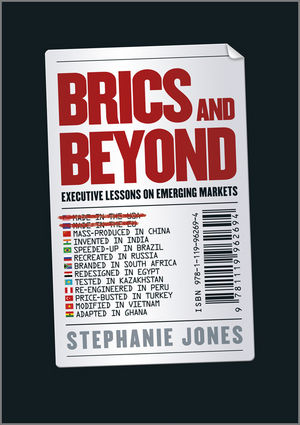A few months ago I was surprised and pleased at the same time to receive a complimentary book from Wiley in my mailbox. I was wondering why – maybe because this blog is meant for MBA students (something mentioned on the back cover) and I wrote many posts about BRICS countries? Well actually it was the result of a participation to a monthly competition at Business Because – so you too you can participate and win! And thanks, Business Because, for the very interesting book!
 Here are the technical details about the book: “BRICS and BEYOND” by Stephanie Jones, Wiley 2012, ISBN 978-1-119-96269-4 (also available as e-book). Dr Stephanie Jones is Associate Professor of Organizational Behavior at Maastricht School of Management. She lived and worked around the world (Hong Kong, China, India, Australia, Dubai and Kuwait according to her bio) and has therefore a good background to write this book. The first thing that strikes with this book is its cover: it basically states that every step of a product life cycle is now happening outside the US or the EU (except consumption perhaps).
Here are the technical details about the book: “BRICS and BEYOND” by Stephanie Jones, Wiley 2012, ISBN 978-1-119-96269-4 (also available as e-book). Dr Stephanie Jones is Associate Professor of Organizational Behavior at Maastricht School of Management. She lived and worked around the world (Hong Kong, China, India, Australia, Dubai and Kuwait according to her bio) and has therefore a good background to write this book. The first thing that strikes with this book is its cover: it basically states that every step of a product life cycle is now happening outside the US or the EU (except consumption perhaps).
The Vlerick Business School curriculum is not really focused on BRICS (nor emerging markets). However the full-time MBA has lots of participants coming from these countries. And even in the executive MBA (with mainly Belgians), there is (in my opinion) a certain interest in these countries (it is sufficient to mention that the study trip to China is fully booked in a few minutes …). And Western MBA students are clearly the target population of this book.
The structure of the book is somewhat classical. There are tree main parts: risks, opportunities and practise. You will be able to make links with – or more appropriately: make extensions of – several classes taught at Vlerick (and in all MBAs): CSR, marketing, entrepreneurship, innovation, strategy, operations, etc. But don’t expect to find any 2-by-2 matrices: this book is more about learning from experience than applying glossy frameworks.
This brings me to what I liked in this book: you have many ways to read it …
- You can read the second cover and you will have very quickly 8 “must-know” sentences.
- You can read “Executive Lessons” at the end of each chapter and you know a bit more.
- Or you can just read one chapter you fancy at a time, on a specific topic – and there you go.
- (and of course you can take some time and read it from the first page to the last one).
Something I also appreciated in the book is to have many practical “mini cases” (called “brief worked examples”). They illustrate each of the lessons detailes in the previous chapter. Very often MBA textbooks explain theory and concepts in great details but fail to deliver very practical examples you can relate to in your everyday life. Not here. This is again another illustration of the power of storytelling.
Some regrets? Although corruption and bribery is covered, there is nothing about regular finance and accounting. The topic is obviously very technical and vary in each emerging market. But you better know it before. And the author may have struggled to give a balance in the different countries to discuss. China and India indeed occupy the majority of examples. This is obviously normal as they enjoy great economic powers and a large part of the world population. However BRICS and emerging markets deal with other countries too. Most of these other countries are cited in one or several examples here and there – but at the end of the book the reader should expect to know more on India and China than Congo or Brazil for instance.
In a nutshell? “BRICS and Beyond” is a book you will enjoy reading if you are interested in emerging markets. It will give you an interesting introduction as well as key points to focus on when doing business there. And it will be complemented by more specialised reading (e.g. targeting a country or a topic specifically) but more importantly by your own experience!
 Among the nearly 200 participants in the BusinessBecause When I Retire competition Vlad Damian, a Vlerick FTMBA, shared his vision of his world at retirement time, how he thinks the world will have changed at that time. It starts with …
Among the nearly 200 participants in the BusinessBecause When I Retire competition Vlad Damian, a Vlerick FTMBA, shared his vision of his world at retirement time, how he thinks the world will have changed at that time. It starts with …